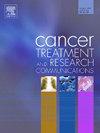表皮生长因子受体特异性免疫治疗SHH髓母细胞瘤的体外血脑屏障模型试验
Q3 Medicine
引用次数: 0
摘要
尽管小儿恶性肿瘤如shh -髓母细胞瘤(SHH-MB)的治疗取得了进展,但目前的治疗标准仍然是手术后化疗和放疗。这种积极的治疗伴随着显著的发病率和许多长期的副作用,特别是在儿童和青少年中。因此,迫切需要更多的靶向治疗。结合肿瘤抗原特异性抗体的免疫毒素(ITs)已显示出选择性靶向肿瘤细胞的潜力。在这项研究中,我们生成了基于单链可变片段(scFv)的IT,其中包含假单胞菌外毒素a (ETA’)的截断,免疫原性较低的变体。它特异性靶向表皮生长因子受体(EGFR),这是一种肿瘤相关抗原,通常在SHH-MB中过表达。我们可以证明这种免疫治疗方法降低肿瘤细胞活力并诱导mb细胞系凋亡,IC50值在3.1至17.5 nM之间。鉴于SHH-MB表现出PI3K通路信号失调,我们将其与PI3K抑制剂联合使用。联合处理导致IC50值的剂量依赖性降低(从0.5µM开始浓度时的2.51 - 13.9 nM降至2µM开始浓度时的1.01 - 3.4 nM)。此外,我们可以在基于人脑微血管内皮细胞(HBMEC)的体外血脑屏障模型中证明生成的IT可以成功地在体外穿过血脑屏障(BBB)。这些结果表明,这种免疫治疗方法具有进一步开发和临床应用的前景。本文章由计算机程序翻译,如有差异,请以英文原文为准。
Epidermal growth factor receptor specific immunotherapy for SHH medulloblastoma tested in an in vitro blood-brain barrier-model
Despite advances in treating pediatric malignant tumors like SHH-medulloblastoma (SHH-MB), the current standard of care remains surgery followed by chemo- and radiotherapy. This aggressive therapy goes along with a significant morbidity with many long-term side effects, especially in children and adolescents. Therefore, more targeted therapies are urgently needed. Immunotoxins (ITs) conjugated to tumor-antigen specific antibodies have shown potential for selectively targeting tumor cells. In this study, we generated a single chain variable fragment (scFv)-based IT that incorporates a truncated, less immunogenic variant of Pseudomonas Exotoxin A (ETA'). The IT specifically targets the epidermal growth factor receptor (EGFR), a tumor-associated antigen commonly overexpressed in SHH-MB. Wecould demonstrate that this immunotherapeutic approach reduces tumor cell viability and induces apoptosis in MB-cell lines with IC50 values ranging from 3.1 to 17.5 nM. Given that SHH-MB exhibit dysregulated PI3-kinase (PI3K) pathway signaling, we combined the IT with a PI3K inhibitor. Combination treatment led to dose-dependent reductions in IC50 values (from 2.51 – 13.9 nM at 0.5 µM start concentration to 1.01 – 3.4 nM at 2 µM start concentration). Additionally, we could demonstrate that the generated IT can successfully cross the blood-brain barrier (BBB) in vitro in an in vitro BBB-model based on human brain microvascular endothelial (HBMEC) cells . These results suggest that this immunotherapeutic approach is a promising candidate for further development and clinical application.
求助全文
通过发布文献求助,成功后即可免费获取论文全文。
去求助
来源期刊

Cancer treatment and research communications
Medicine-Oncology
CiteScore
4.30
自引率
0.00%
发文量
148
审稿时长
56 days
期刊介绍:
Cancer Treatment and Research Communications is an international peer-reviewed publication dedicated to providing comprehensive basic, translational, and clinical oncology research. The journal is devoted to articles on detection, diagnosis, prevention, policy, and treatment of cancer and provides a global forum for the nurturing and development of future generations of oncology scientists. Cancer Treatment and Research Communications publishes comprehensive reviews and original studies describing various aspects of basic through clinical research of all tumor types. The journal also accepts clinical studies in oncology, with an emphasis on prospective early phase clinical trials. Specific areas of interest include basic, translational, and clinical research and mechanistic approaches; cancer biology; molecular carcinogenesis; genetics and genomics; stem cell and developmental biology; immunology; molecular and cellular oncology; systems biology; drug sensitivity and resistance; gene and antisense therapy; pathology, markers, and prognostic indicators; chemoprevention strategies; multimodality therapy; cancer policy; and integration of various approaches. Our mission is to be the premier source of relevant information through promoting excellence in research and facilitating the timely translation of that science to health care and clinical practice.
 求助内容:
求助内容: 应助结果提醒方式:
应助结果提醒方式:


